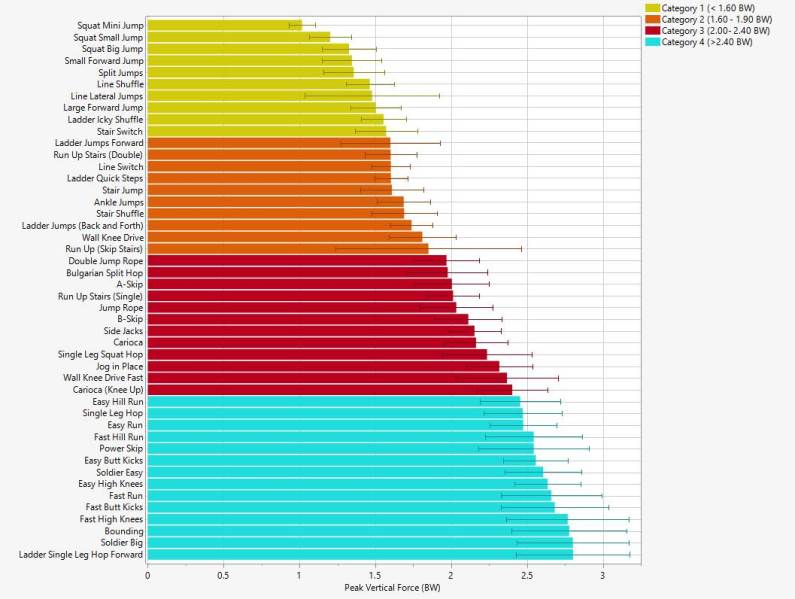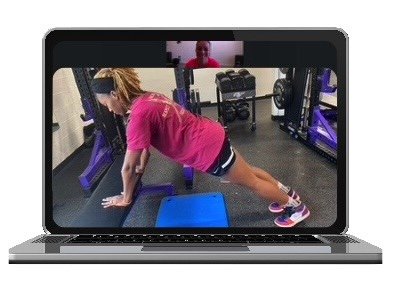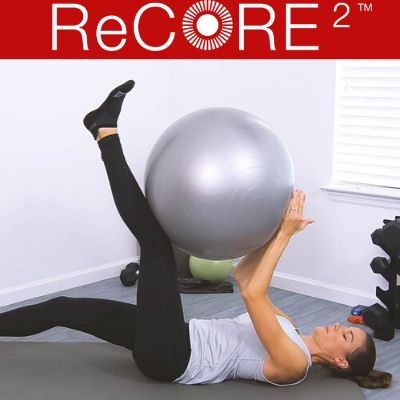Training Drills in Postpartum Return-to-Run Programs

Abstract-
Quantifying the External Loading of Running Drills: Ranking Drills to Design Progressive Postpartum Return-to-Run Programs
Celeste Goodson1, Aubree McLeod1, Max R. Paquette2
1ReCORE Fitness, Franklin, TN, U.S.A
2University of Memphis, Memphis, TN, U.S.A
Introduction:
During running, vGRF increases proportional to speed, with high speeds (e.g., 9-12 m/s) reaching forces over 4x bodyweight (1). During periods of decreased pelvic floor strength or altered muscle activity (such as the postpartum period), high-impact activity is considered a risk factor for pelvic floor dysfunction, prolapse symptoms and urinary incontinence (2-3). Postpartum return-to-run protocols should include a gradual increase in external loading over time to allow progressive loading and subsequent adaptation of pelvic floor musculature. Drills are valuable in this progression as they can mimic the motions and muscle activations of running with lower magnitudes of vertical force compared to running (4). The purpose of this study was to quantify and rank the vertical force magnitude of common training drills, to provide clinicians with a tool to program postpartum return-to-run protocols.
Methods:
11 experienced runners completed five trials of 46 training drills while in-shoe vertical reaction forces (vRF) were measured with wireless force insoles (100Hz, loadsol, Novel, Inc). Average peak vRF was calculated for each drill, and drills were ranked in order from least to greatest vRF.
Results:
Drills were ranked by increasing vRF (Figure 1). The drill titled “Single Leg Hop Forward” demonstrated the highest vRF at 2.8 BW, while the “Squat Mini Jump” drill demonstrated the lowest vRF at 1.0 BW.
Discussion/Conclusion:
Early postpartum runners should begin rehabilitation with low vertical force drills, and progress gradually as pelvic floor strength and coordination improves. The clinician should take care to slowly increase the total load on the pelvic floor, which is dependent on both magnitude and loading rate of vRF, as well as the number of repetitions. Though not measured in this study, drill vertical oscillation (vertical movement of center of mass) also affects the load experienced by the pelvic floor. As a result, some of the low impact drills with high vertical oscillation (such as “Large Forward Jump” or “Split Jumps”) may not be suitable early on for those with pelvic floor dysfunction. The selection of specific drills and the speed at which a runner should be moved through drills depends on the individual- additional factors such as birth injuries, other musculoskeletal issues, athlete goals and of course patient feedback should also be taken into account. Though these data only lays out a uni-dimensional aspect of the postpartum rehabilitation process, it provides a valuable tool for clinicians and practitioners to more objectively program return-to-running (and vertical force) training for postpartum runners.
Complete Data and Figures (46 Training Drills):
Training Drills and Vertical Force:
46 Training Drills ranked and categorized by Average Peak vRF (± 95% Confidence Interval). “% Fast Running” column refers to the % of the Average Peak vRF measured during “Fast Running” (performed at a 10K race pace). Categories are arranged by bodyweight (BW) and are as follows: Category 1 (<1.60 BW), Category 2 (1.60-1.90 BW), Category 3 (2.00-2.40 BW), Category 4 (>2.40 BW). Categories are provided for ease in clinical use.

|
Rank |
Drills |
Average Peak vRF ± CI (BW) |
% Fast Running |
Category |
|
1 |
Squat Mini Jump |
1.02 ± .09 |
38% |
1 |
|
2 |
Squat Small Jump |
1.20 ± .14 |
45% |
1 |
|
3 |
Squat Big Jump |
1.32 ± .18 |
50% |
1 |
|
4 |
Small Forward Jump |
1.35 ± .20 |
51% |
1 |
|
5 |
Split Jumps |
1.36 ± .20 |
51% |
1 |
|
6 |
Line Shuffle |
1.46 ± .16 |
55% |
1 |
|
7 |
Line Lateral Jumps |
1.48 ± .44 |
56% |
1 |
|
8 |
Large Forward Jump |
1.50 ± .17 |
56% |
1 |
|
9 |
Ladder Icky Shuffle |
1.55 ± .15 |
58% |
1 |
|
10 |
Stair Switch |
1.57 ± .20 |
59% |
1 |
|
11 |
Ladder Jumps Forward |
1.60 ± .33 |
60% |
2 |
|
12 |
Run Up Stairs (Double) |
1.60 ± .17 |
60% |
2 |
|
13 |
Line Switch |
1.60 ± .13 |
60% |
2 |
|
14 |
Ladder Quick Steps |
1.60 ± .11 |
60% |
2 |
|
15 |
Stair Jump |
1.61 ± .21 |
60% |
2 |
|
16 |
Ankle Jumps |
1.69 ± .18 |
63% |
2 |
|
17 |
Stair Shuffle |
1.69 ± .21 |
64% |
2 |
|
18 |
Ladder Jumps (Back and Forth) |
1.74 ± .14 |
65% |
2 |
|
19 |
Easy Wall Knee Drive |
1.81 ± .22 |
68% |
2 |
|
20 |
Run Up Stairs (Skip Stairs) |
1.85 ± .61 |
70% |
2 |
|
21 |
Double Jump Rope |
1.97 ± .22 |
74% |
3 |
|
22 |
Bulgarian Split Hop |
1.98 ± .26 |
74% |
3 |
|
23 |
A-Skip |
2.00 ± .24 |
75% |
3 |
|
24 |
Run Up Stairs (Single) |
2.01 ± .17 |
76% |
3 |
|
25 |
Jump Rope |
2.03 ± .24 |
76% |
3 |
|
26 |
B-Skip |
2.11 ± .22 |
79% |
3 |
|
27 |
Side Jacks |
2.15 ± .17 |
81% |
3 |
|
28 |
Carioca |
2.16 ± .21 |
81% |
3 |
|
29 |
Single Leg Squat Hop |
2.24 ± .30 |
84% |
3 |
|
30 |
Easy Jog in Place |
2.32 ± .22 |
87% |
3 |
|
31 |
Fast Wall Knee Drive |
2.37 ± .34 |
89% |
3 |
|
32 |
Carioca (Knee Up) |
2.40 ± .23 |
90% |
3 |
|
33 |
Easy Hill Run |
2.46 ± .26 |
92% |
4 |
|
34 |
Single Leg Hop |
2.47 ± .26 |
93% |
4 |
|
35 |
Easy Run |
2.47 ± .22 |
93% |
4 |
|
36 |
Fast Hill Run |
2.54 ± .32 |
96% |
4 |
|
37 |
Power Skip |
2.54 ± .36 |
96% |
4 |
|
38 |
Easy Butt Kicks |
2.56 ± .21 |
96% |
4 |
|
39 |
Soldier Easy |
2.60 ± .25 |
98% |
4 |
|
40 |
Easy High Knees |
2.64 ± .22 |
99% |
4 |
|
41 |
Fast Run |
2.66 ± .33 |
100% |
4 |
|
42 |
Fast Butt Kicks |
2.68 ± .35 |
101% |
4 |
|
43 |
Fast High Knees |
2.77 ± .40 |
104% |
4 |
|
44 |
Bounding |
2.78 ± .38 |
104% |
4 |
|
45 |
Soldier Big |
2.80 ± .37 |
105% |
4 |
|
46 |
Ladder Single Leg Hop Forward |
2.80 ± .37 |
105% |
4 |
Training Drill Execution:
Drills labeled as “Easy” were performed at the cadence of an easy running pace. Drills labeled as “Fast” were performed at the cadence of a 10K race pace.
|
Drill |
Explanation |
|
A-Skip |
High knee march while skipping, with a focus on landing midfoot, close to center of mass |
|
Ankle Jumps/Hops |
Quick jumps from the ankles (keep legs straight), landing midfoot, keeping toes up |
|
B-Skip |
A-Skip with knee extension before landing midfoot, close to center of mass |
|
Bounding |
Exaggerated running stride, increasing vertical and horizontal displacement. |
|
Bulgarian Split Hop |
Bulgarian split squat with front leg hop |
|
Carioca |
Moving left- step cross right leg laterally, first in front then behind left leg. Repeat with left leg while moving right |
|
Carioca (Knee Up) |
Carioca Drill with traveling leg knee drives upwards during cross |
|
Double Jump Rope |
Jump rope in place, jumping twice between swings |
|
Easy Butt Kicks |
Pull heel of foot towards butt and land on ball of foot. Alternate legs |
|
Easy High Knees |
Drive knee to hip height and land on ball of foot. Alternate legs |
|
Easy Hill Run |
Easy run up 10% grade slope |
|
Easy Run |
Run at easy pace |
|
Fast Hill Run |
Fast run up 10% grade slope at 10K race pace |
|
Fast Run |
Run at 10K race pace |
|
Fast Butt Kicks |
Pull heel of foot towards butt and land on ball of foot. Alternate legs quickly |
|
Fast High Knees |
Drive knee to hip height and land on ball of foot. Alternate legs quickly |
|
Easy Jog in Place |
Easy paced running motion in place |
|
Jump Rope |
Jump rope in place, single jump between swings |
|
Ladder Icky Shuffle |
Going forward through ladder, R-in, L-in, R-out, L-out, as quickly as possible. |
|
Ladder Jumps (Back and Forth) |
Jump off both feet forward and backward (double feet landing) over one ladder line as quickly as possible |
|
Ladder Jumps Forward |
Jump off both feet forward to each ladder square (double feet landing) as quickly as possible |
|
Ladder Quick Steps |
R then L in each ladder square going forward as quickly as possible |
|
Ladder Single Leg Hop Forward |
Single leg hops forward through each ladder square as quickly as possible |
|
Large Forward Jump |
Big jump forward off two feet, landing on two feet |
|
Line Lateral Jumps |
Feet together, jump laterally back and forth across a line |
|
Line Shuffle |
One foot at a time moving laterally back and forth across a line. R, L to side, R, L back to starting position as quickly as possible |
|
Line Switch |
One foot in front of the other, switch feet as quickly as possible |
|
Power Skip |
Lift knee and spring off opposite foot into air. Alternate legs |
|
Run Up Stairs (Skip Stair) |
Fast pace up stairs, single leg lands on every other step |
|
Run Up Stairs (Double) |
Fast pace up stairs, both feet land on each step |
|
Run Up Stairs (Single) |
Fast pace up stairs, single leg landing on each step |
|
Side Jacks |
Step laterally with R and follow with L to step together. Raise and lower both arms alternately on the R lateral step |
|
Single Leg Hop |
Hop and land on single leg |
|
Single Leg Squat Hop |
Single leg squat with hop at top of motion, land on single leg |
|
Small Forward Jump |
Small forward jump off two feet, landing on both feet |
|
Soldier Big |
Straight leg bounds, hitting ground hard with midfoot as you go forward |
|
Soldier Easy |
Straight leg bounds, hitting ground lightly with midfoot as you go forward |
|
Split Jumps |
Stand with legs staggered right in front of left. Jump and switch legs to land left in front of right. Alternate legs |
|
Squat Big Jump |
Double leg squat with large jump at top of motion |
|
Squat Mini Jump |
Double leg squat with small jump at top of motion. Toes do not leave the ground |
|
Squat Small Jump |
Double leg squat with small jump into air at top of motion |
|
Stair Jump |
Jump with both feet up (double feet landing) each stair |
|
Stair Shuffle |
One foot at a time up and down the step. R, L forward, R, L backward as quickly as possible |
|
Stair Switch |
One foot on the step, one on ground, switch feet at same time as quickly as possible |
|
Easy Wall Knee Drive |
With feet several feet away, lean into the wall, leading with hips and brace with arms. Drive knee up keeping toe up. Switch legs quickly, hitting the ground midfoot with force |
|
Fast Wall Knee Drive |
Perform knee drive at a quick pace, keeping toes up. |
References:
- Churchill S, Salo A, Trewartha G, et al. Force Production During Maximal Effort Sprinting on the Bend. In: 30th Annual Conference of Biomechanics in Sport, Melbourne, 2012, pp.117–122.
- DeLancey JOL, Kane Low L, Miller JM, et al. Graphic integration of causal factors of pelvic floor disorders: An integrated life span model. Am J Obstet and Gynecol 2008; 199: 1–12.
- Sangsawang B, Sangsawang N. Stress urinary incontinence in pregnant women: A review of prevalence, pathophysiology, and treatment. Int Urogynecol J 2013; 24: 901–912.
- Johnson ST, Golden GM, Mercer JA, et al. Ground-Reaction Forces during Form Skipping and Running. J Sport Rehabil 2005; 14: 338–345.




















Aubree McLeod is an ACSM-EP exercise physiologist, researcher in running biomechanics. She has also completed the ICE Preg & PostPartum Course for athletes. She has an M.S. in Exercise Science and has worked in a variety of spaces within the exercise science field including physical therapy, education, research, and run coaching for... Read More